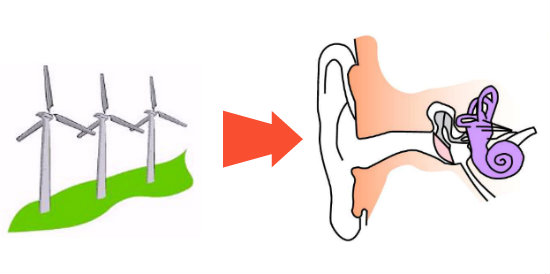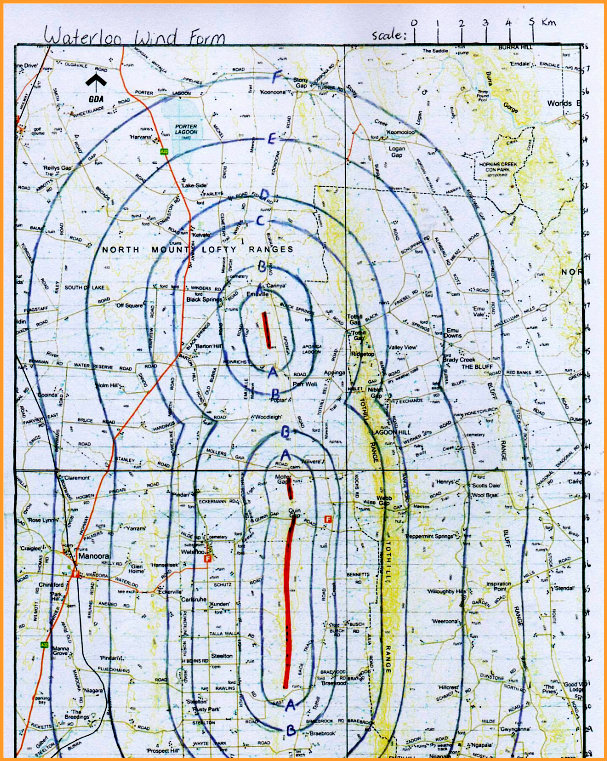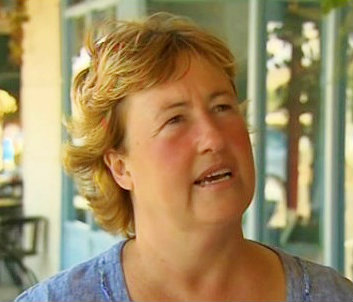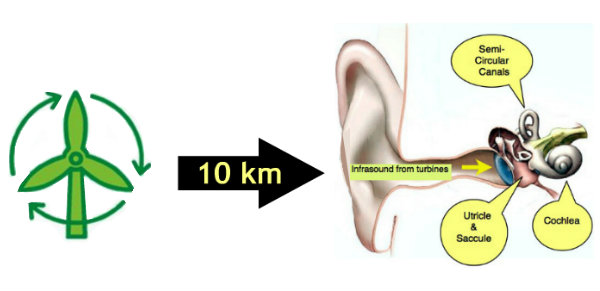Streamlined noise study process for wind turbines (Cartoon)



Editor’s note: The following Letter to the Editor was written by a lady in Staynor, Ontario, Canada, describing her outrage against a wind energy developer and local officials and residents who support turning her community into an industrial wasteland.
.
—Melodie Burkett (8/29/12)
This is what I said to the wind energy weasel who offered me $30,000/year for 20 years if I would sign a contract to host 3 huge turbines on my land. He asked me, as well, to add my initials to the clause forbidding me ever to say anything negative about wind turbines on my land. (Pardon me!)
He told me not to get too excited, as he had yet to get all the other farmers on the ridge to sign up.
He gave me a colourful brochure and told me to make sure I did my “due diligence” and researched the wonders of industrial-sized turbines.
I flipped through the brochure and saw the big pictures of big white wind turbines. It struck me that the beautiful farm in the brochure had lost the look and feel of a farm and now looked hideous; it looked like an industrial wasteland.
I looked at this guy in the white shirt and tie and asked him,
Wouldn’t you do better selling Filter Queen vacuum cleaners or time-shares in Mexico? I would prostitute myself before I would prostitute my farm or sell-out my neighbours or betray the pioneers who worked so hard to clear this land and build what came to be called Clearview. CLEAR view, Get IT? That’s what it’s known for! The breathtaking vistas that attract people looking to settle in a peaceful country setting. The tourists who come to shop in the quaint little shops or the bicycle people who pedal our hills and dales each weekend.”
I had already done my “due diligence” and researched the “marvels” of wind power. The first thing I noticed was that when a company tries to woo a community, their salesmen tell big whoppers! They say things like the “X number of megawatts we put out will power Y number of homes for your community”! They don’t tell you they are quoting NAMEPLATE CAPACITY! A capacity that is never reached! My speedometer on my dash tells me my car can go 220 kph—but in reality would it ever do that? It turns out that wind contributes less that 1 % to the Ontario energy supply, and less than 5% worldwide!
The next big whopper they tell is that wind turbines will reduce carbon emissions and stop climate change. Oh really? How can that be when our gas plants have to run “hot at the ready” to amp up or down as the wind turbines go on and off the grid? All that up and down, up and down, up and down causes more emissions and wastes fossil fuels. If we are trying to get off fossil fuels and save the planet, why did Germany build 26 new coal plants to stand at-the-ready to provide baseload electricity when the fickle wind decides not to blow? How come China builds a new coal plant each week to back up its wind turbines?
Do you not think that if any significant reduction in emissions were made anywhere in the world due to wind turbines that this would make headline news? Do you notice that a big company like WPD never seems to mention how much emissions have been avoided in reality?
Again, wind companies spew out nameplate capacity, then extrapolate how much emissions they prevent. It is a big fat lie!
Now I have to tell you my heart did a flip flop when first I read Jeff Watchorn’s letter demanding more from our elected representative and Deputy Mayor than the usual Pollyanna blather about how she supports anything “green.” This is the lady who has twice gone public and announced in no uncertain terms that she’s glad the province enacted the Green Energy Act and took this off our plate. “We don’t have time to get involved in the wind turbine debate” (I paraphrase).
Say what? You don’t have time to become involved in the most serious issue to confront Clearview in the history of Clearview? The issue that will impact our township and the families that have built their lives here, for the rest of our lives? That is shocking and downright shameful. It leaves me speechless! Except to say, “You bake a good cake, Alicia. Consider staying home and baking cakes for your husband.”
Why did my heart do a flip flop? Because on the very next page of the local paper, right after Jeff Watchorn’s excellent letter, we got some more blather from a Creemore man who claims he likes to drive by a wind farm and look at the majestic 50-story wind turbines. Well, sir, drive to Shelburne, and knock yourself out! I notice you didn’t say you wanted to live amongst them.
Then this guy goes on to say that tourism is not affected at Niagara Falls or the Hoover Dam in Nevada. Duh! News flash: Apples are not oranges! He then winds on about how “green” turbines are and how much fossil fuel they save. Yup, he drank the Green Kool-Aid right off the wind carpetbagger brochure! I imagine him as one of those nincompoops who stands beneath a 50-story wind turbine and has an orgasm over how quiet it is. Another news flash: Sound travels! Imagine a mammoth machine anchored to bedrock, throbbing and pulsing out vibrations that have been picked up in a study by Scottish seismologists 10 miles out! This what’s causing all the heartache in Ontario and rural communities around the world. (Please note that the original wind turbines in Europe were only 100 feet tall, not the 60-story ones they are erecting in Ontario today.)
These folks that have had to abandon their homes in order to stop the headaches, tinnitus, vertigo, sleep deprivation and nausea are not whistling Dixie, pal; they are sick, their kids are sick and they had to leave their life’s dream and home. Most had to let the bank foreclose their home as they could not pay rent in town and continue to pay a mortgage on their abandoned home.
Finally, after 5 years, someone listened and now a proper health study is underway. Until the results are in, many townships are demanding a moratorium on all future building of wind factories. Anything less is criminal.
By the way, sir, did you know that banks are not giving mortgages to families in close proximity to a wind factory? Banks (correctly) note that the value of the home is not the market value it was beforehand. And did you know that Insurance companies won’t insure a farm that hosts wind turbines? It seems they realize they can’t control the numerous people willy nilly coming onto the land to service the machines, meaning the insurer would be exposed to too much liability. Great huh?
Well Mr. Pollyanna, if WPD gets their final approval and builds their Fairview wind factory, you can rent my farmhouse very cheap. Then you can think about how wonderful they are at 3 o’clock in the morning when you can’t get to sleep. Come and see me; my farm is the beautiful one with all the signs saying “Wind Turbines Make Bad Neighbours” and “Wind Turbines: A BIG FAT LIE!”
Oh, I almost forgot. The UN has asked the European Union to rethink their energy policy. It seems the thousands and thousands of wind turbines to date have not produced the energy they predicted, and the EU cannot afford this farce any longer. Guess they thought they would get more bang for their buck. (Yeah, and I thought my car would drive 220 kph ‘cause it says so on the speedometer.)

Editor’s note: The following is a Letter to the Editor of the Boston Globe (8/26/12), written by a civil engineer and registered land surveyor in Scituate, MA.
—David M. Dardi (Scituate, MA), 8/26/12
In a letter to the Globe South on Aug. 19 (“Scituate majority favors windmill”), Allan Greenberg’s assertion that I should have expressed my views about the wind turbine prior to its construction is overly simplistic.
Since none of us have ever lived near a windmill, we didn’t know what to expect and relied on our community leaders to protect us. One resident whose house is only a few hundred feet from the windmill distributed printed information about the adverse effects to the Scituate Planning Board at their Feb. 12, 2009, meeting and voiced his concerns again at the July 12, 2010, meeting. He was told that he would not experience any negative effects. We now know that to be false.
Since the Aug. 9 article in Globe South (“Winds of discontent in Scituate”), many people have contacted both the Globe writer and myself with their own stories of shadow flicker, noise disturbance, and sleep deprivation. I have urged them to make their complaints to the Board of Health, since they have the power to mitigate the situation.
Mr. Greenberg has portrayed me as anti-windmill, and I am not. I am for any alternate source of energy that does not present public health issues. If I had been aware of the wind turbine before it was built, I would not have had any views to bring forward since I have had no experience with them. At that time, I was a member of the ignorant majority, but now it is a different story.
I have been awakened many times and have been forced to shut the windows and take doctor-prescribed sleeping pills. The closest involvement most people will ever have with a windmill is seeing it when they drive by it. It is very easy to support something that you only read about and go to visit, but they should try sleeping under it.
 .
.
(Click here for the original article)
.
—Alec N. Salt, Ph.D., Cochlear Fluids Research Laboratory, Dept. of Otolaryngology, Washington University School of Medicine (St. Louis, Missouri)
Large wind turbines generate very low frequency sounds and infrasound (below 20 Hz) when the wind driving them is turbulent. The amount of infrasound depends on many factors, including the turbine manufacturer, wind speed, power output, local topography, and the presence of nearby turbines (increasing when the wake from one turbine enters the blades of another). The infrasound cannot be heard and is unrelated to the loudness of the sound that you hear. Infrasound can only be measured with a sound level meter capable of detecting it (and not using the A-weighted scale). Video cameras and other recording devices are not sensitive to infrasound and do not reproduce it.
You cannot hear the infrasound at the levels generated by wind turbines, but your ears are indeed detecting and responding to it. The picture shows the enormous electrical potentials that infrasounds generate in the ear. The potentials (18.7 mV pk/pk amplitude in this case) are about 4 times the amplitude of any sounds that are heard. This shows the low frequency part of the ear is extremely sensitive to infrasound. Infrasound generates larger electrical responses than any other type of sound, including sounds you can hear presented at the loudest levels.
The ear is most sensitive to infrasound when other, audible sounds are at low levels or absent. That is why homes and pillows contribute to the problem. To clarify, maximum stimulation of the ear with infrasound will occur inside your home, because the audible sound of the turbines is blocked by the walls of the house, but infrasound readily passes through any tiny openings. Similarly, sleeping with one ear on a pillow will block audible sound to that ear but will not block the infrasound. In either case, the infrasound will be strongly stimulating the ear even though you will not be able to hear it. The presence of sounds at higher frequencies, in the 150 Hz – 1500 Hz range at levels above 60 dB SPL, suppresses the ear’s response to infrasound. It may be possible to mask the influence of infrasound with other noises but the frequency properties of the masking noise must be carefully considered. Frequencies above about 1500 Hz will not do anything to help. So before you use a fan or noise masker provided by the turbine company, be sure the noise has the necessary characteristics.
We know that the ear is being stimulated by this sound, but why would that matter if you cannot hear it?
There are several ways that infrasound could affect you even though you cannot hear it. They are:
(1) Causing Amplitude Modulation (pulsation) of heard sounds
We know that infrasound affects the sensory cells of the ear in a way that changes their sensitivity (like turning the volume control of the stereo up and down repeatedly). This is a biological form of amplitude modulation that cannot be measured with a sound level meter. The people who are measuring amplitude modulation of heard sounds with sound meters are looking at something completely different. Biological amplitude modulation can be much more powerful, with the volume cycling from going from “off” to “full”, rather than just changing a few dB. So, to investigate amplitude modulation without considering the infrasound-induced component is never going to explain the true nature of the problem. Symptoms: Pulsation, annoyance, stress.
(2) Stimulating “subconscious” pathways
We know that activity in many nerves of the ear does not result in “hearing”. If the nerves from the utricle or semi-circular canals are stimulated, you may get eye movements and changes in tension of neck muscles, but you don’t hear it. The pathway of conscious hearing is very well established. It goes from the inner hair cells of the cochlea, through type I auditory nerve fibers, to the fusiform cells of the cochlear nucleus in the brain, and so on. This pathway has been well-studied. The outer hair cells of the ear (the ones that are sensitive to infrasound) do not connect to this conscious pathway. They connect to the type II nerves (which make up 5% of the nerve fibers), then to granule cells in the brain, then to cartwheel cells and to a host of other pathways in the brain. The cartwheel cells are known to be inhibitory to hearing which may explain why the stimulation is not heard. It is known that granule cells are connected into circuits related to attention and alerting. It is not unreasonable to think that stimulation of this pathway could wake you up, and you wouldn’t even hear what had actually woken you. Symptoms: Sleep disturbance, panic, with chronic sleep deprivation leading to blood pressure elevation, memory dysfunction and more.
(3) Causing Endolymphatic Hydrops
The endolymph is a fluid filled compartment in the ear, like a balloon, surrounded by delicate membranes. In some conditions, such as in people with Meniere’s disease, a swelling of this compartment occurs. These patients suffer from repeated vertigo spells, fluctuating low frequency hearing loss, tinnitus and a sensation of fullness or pressure in the ear. Low frequency sounds, at levels that are not damaging and do not affect hearing, have been shown to cause endolymphatic hydrops. This can occur quickly, but also recovers quickly so there are minimal consequences. This effect has been demonstrated with tones as low as 50 Hz, but has never been studied with lower sound frequencies or with infrasound. There is no reason to believe that lower frequency sounds will not generate hydrops, as we know that endolymphatic responses to infrasound are larger than those to heard sounds. As hydrops develops, endolymph moves and expands the weakest part of the balloon, which is the saccule. The saccule is the body’s gravity receptor, so if it is disturbed you will feel “off balance”, dizzy (subjective vertigo) and nauseaous, especially if only one ear is affected (maybe the one you had on the pillow?- see above). Studies so far have only studied this for brief exposures of a few minutes. Effects are likely to increase with prolonged exposure to the sound. Furthermore, when the endolymphatic hydrops reaches a degree where the helicotrema of the cochlea is occluded, this makes the ear about 20 dB more sensitive to the low frequency sound and will undoubtedly exacerbate the problem. Symptoms: Unsteadiness, dysequilibrium, vertigo, nausea, “seasickness”, tinnitus, sensation of pressure or fullness in the ear.
(4) Possibly Accelerating Presbyacusis (making you go deaf faster over the years)
In animals exposed to damaging noise, with and without low frequency sound present, animals had larger areas of damage when low frequency sound was present. So, if you are doing anything noisy (mowing the yard, using a chainsaw) the damage to your ears could be greater if low frequency or infrasound levels are high. Such effects may be small and may take 30-40 years to become apparent. (Unfortunately, in 40 years this will make a great epidemiological project for someone). But in the meantime, be very careful and wear hearing protection when pursuing noisy pastimes near sources of infrasound (that you can’t even hear). As a side-note, hearing protectors, especially the over-the-ear cup type, will not protect against infrasound even though they do reduce the damaging sounds you can hear. Even, in-the-ear foam plugs will not stop infrasound. Infrasound can only be blocked by a solid earplug, either custom fitted to the ear canal or sealed with jelly to generate an air-tight seal.
The above mechanisms are not speculation. Each is based on published data showing the phenomenon exists, thus making it a scientifically plausible process. No one has shown that any of these four mechanisms cannot occur. Of course, the degree to which each phenomenon occurs in humans following prolonged exposure to the infrasound from wind turbines has not yet been demonstrated. But each phenomenon now needs to be studied in more detail. The potential symptoms they could generate in people seem quite familiar, though.
The Wind Turbine Industry is generally dismissive of claims that wind turbines can affect human health. For example, Scott Smith, Vice President of Policy for CanWEA (the Canadian Wind Energy Association), referring to the report of the Chatham-Kent Tribunal (Spring 2011) stated “The wind energy industry welcomes the tribunal’s decision, as it is consistent with the balance of expert scientific and medical information which clearly indicates there is no direct link between wind turbines and effects on human health” (my emphasis added).
This dismissive statement fails to recognize another important recommendation of the Chatham-Kent tribunal, specifically “that there are some risks and uncertainties associated with wind turbines that merit further research.”
We agree that the effects of wind turbine noise on humans are largely unexplored and more research is needed. We believe that the infrasound levels generated by some large wind turbines are unusual in the environment and that there have been no systematic long-term studies of prolonged exposure to such sounds on humans or other animals.
The wind industry has taken the position that if you cannot hear the infrasound, then it cannot affect you. As you can see above, we disagree strongly based on our understanding of how the ear works. These web pages consider in more detail some of the areas that we have expertise (click here and scroll to bottom of page).
.

Professor Alec Salt, PhD

.
Editor’s note: The following is an open letter from Marshall Rosenthal. During the 1960’s, “Marsh” was a front-line worker in the Civil Rights movement. A white Jew in Mississippi, where the Ku Klux Klan persecuted Jews. Marsh was (in his words) “a Health Officer in a pioneer Headstart operation, the Child Development Group of Mississippi.”
This is a man who has wrestled with state-sponsored madness—wrestled with and been wounded by it. (Many in his family were murdered in Hitler’s death camps.) Yet he refuses to give up. He has devoted his life to humane causes, regardless of the risks. “Failure” is not part of his vocabulary.
Marshall Rosenthal is a mensch.
Read his letter and ponder. If someone can initiate a case before UNESCO, Dr. Nina Pierpont will testify before that international body. So, too, will Dr. Sarah Laurie and Dr. Robert McMurtry, and probably Dr. Alec Salt.
Never doubt that a small group of thoughtful, committed citizens can change the world. Indeed, it is the only thing that ever has.”
—Margaret Mead
.
Dear friends,
I have only just returned from a trip to the Massachusetts east coast. I was appalled to see the gigantic “Independence” monster [wind turbine] hanging over Route 3, in Kingston, MA. I know that it is sited 1200 feet from a public school. Those kids are mandated by the state to stay in that building. Must we wait for them to succumb to the “mysterious” effects of Wind Turbine Syndrome? Shouldn’t Gov. Deval Patrick be charged with crimes against humanity? What court would hear such a case?
After we passed the Springfield area, heading west, we passed a convoy of three enormous wind turbine blades going east. We think they were heading toward Route 91 North, to get off on Route 2 West, going to the Hoosic windplant, under construction in Florida and Monroe, MA. The Abbott Memorial School in Florida is about a mile away from the nearest 1.5 MW machine. This is well within the two mile impact radius discerned by Ambrose and Rand in Falmouth.
We are looking at an international humanitarian crisis. UNESCO is charged with assuring the health outcomes of the children of the world. There is a terrible disconnect between what is happening and their awareness. Adults are being hammered into oblivion by their local and national governments. Only an international court of justice could have the stature to intercede.
What shall we do first?
Marsh

Minutes of Goyder Development Assessment Panel refusing consent for Tru Energy’s Stony Gap wind farm:
.
Moved: Mr P Dunn Seconded: Mrs J Kellock
That the Regional Council of Goyder Development Assessment Panel resolves that:
»»» (1) Having considered the Development Application 422/155/11, determine that pursuant to Section 35(2) of the Development Act, 1993, the proposed development is NOT seriously at variance with the Regional Council of Goyder Development Plan.
»»» (2) That for the purposes of Section 33 of the Development Act, 1993, Development Application 422/155/11 be REFUSED Development Plan Consent for the following reason:
»»» It is considered that the nature of the proposed wind farm development will adversely and unreasonably impact on the health and amenity of the locality through noise and vibration caused by the operation and hours of operation of the proposed wind farm development.
.
The proposed wind farm development is at odds with the following Regional Council of Goyder Development Plan Objectives and Principles of Development Control:
2.1. Council Wide – Interface Between Land Uses
Objective 1
»»» Development located and designed to prevent adverse impact and conflict between land uses
Objective 2
»»» Community health and amenity and support the operation of all desired land uses
Principles of Development Control
1. Development should not detrimentally affect the amenity of the locality or cause unreasonable interference through any of the following:
»»» b) noise
»»» c) vibration
»»» g) hours of operation
2. Development should be designed and sited to minimise negative impact on existing and potential future land uses considered appropriate in the locality.
6. Sensitive uses likely to conflict with the continuation of lawfully existing developments and land uses considered appropriate for the zone should not be developed or should be designed to minimize negative impacts.
7. Developments should be designed, constructed and sited to minimize negative impacts of noise and to avoid unreasonable interference.
2.2 Council Wide – Orderly Sustainable Development
Objective 1. Orderly and economical development that creates a safe, convenient and pleasant environment in which to live.

—Christopher Booker, The Sunday Telegraph (8/11/12)
Anyone impressed by the efficient way in which Britain has organised the Olympic Games might consider the stark contrast provided by the shambles of our national energy policy – wholly focused as it is on the belief that we can somehow keep our lights on by building tens of thousands more wind turbines within eight years. At one point last week, Britain’s 3,500 turbines were contributing 12 megawatts (MW) to the 38,000MW of electricity we were using. (The Neta website, which carries official electricity statistics, registered this as “0.0 per cent”).
It is 10 years since I first pointed out here how crazy it is to centre our energy policy on wind. It was pure wishful thinking then and is even more obviously so now, when the Government in its latest energy statement talks of providing, on average, 12,300MW of power from “renewables” by 2020.
Everything about this is delusional. There is no way we could hope to build more than a fraction of the 30,000 turbines required. As the windless days last week showed, we would have to build dozens of gas-fired power stations just to provide back-up for all the times when the wind is not blowing at the right speed. But, as more and more informed observers have been pointing out, the ministers and officials of the Department of Energy and Climate Change (DECC) seem to live in a bubble of unreality, without any practical grasp of how electricity is made, impervious to rational argument and driven by an obsession that can only end in our computer-dependent economy grinding to a halt.
The latest attempt to get them to face reality is by Prof Gordon Hughes, a former senior adviser on energy to the World Bank, now a professor of economics at Edinburgh, whose evidence to the Commons committee on energy and climate change has now been published on the website of the Global Warming Policy Foundation. His most shocking finding is that the pursuit of our Climate Change Act target – to reduce Britain’s CO2 emissions by 80 per cent by 2050 – would cost us all £124 billion by 2020, or £5,000 for every household in the land: not just to build tens of thousands of absurdly subsidised wind turbines, but also for the open-cycle gas-fired power stations needed to provide back-up. To guarantee the same amount of power from combined-cycle gas-fired plants would cost £13 billion, barely a tenth as much.
Furthermore, as Prof Hughes explains, ramping the back-up gas plants up and down would mean running them very inefficiently, and give off so much CO2 that we could end up increasing our overall emissions rather than reducing them. And who is expected to build them or pay for them?
The likelihood that any of this will be understood by those in charge of our national policy can be measured by the fact that the chairman of that Commons committee is Tim Yeo, whose business interests (see the They Work For You website) show that last year he earned, on top of his MP’s wages, more than £100,000 by working – at up to £800 an hour – for firms which make money out of renewables.
When Peter Lilley MP raised Prof Hughes’s figures in the Commons, he was contemptuously put down by the DECC minister Charles Hendry, saying that he did not agree with Prof Hughes (on grounds which showed he hadn’t understood the points at issue at all) – and, he added, “neither does the Committee on Climate Change”. The new chairman of this committee, set up under the Climate Change Act, is Lord Deben (formerly John Gummer), whose various lucrative activities relating to the environment include his chairmanship of Forewind, an international consortium planning the world’s largest offshore wind farm, with thousands of turbines, on the Dogger Bank.
The promoters of the wind industry have managed to occupy all the commanding heights of our energy policy, and the only way it might conceivably be brought back into any contact with reality would be through a massive and well-informed counter-attack by a large number of those elected to represent us in Parliament. But as we learnt from the letters on the Climate Change Act recently sent to my readers by more than 70 MPs, they seem to be just as firmly locked into the bubble of make-believe as those who framed these delusional policies in the first place.
I have now been asked by an Oxford academic, specialising in the interface between science and politics, whether she could undertake a detailed analysis of the letters, to see what they tell us about the degree to which our MPs grasp one of the most critical issues confronting our country. In due course, I hope to report on the results. I fear they will not be very encouraging.

—Calvin Luther Martin, PhD
This spring, a bright woman named Mary Morris conducted a survey of the Waterloo Wind Farm (Australia), to see how many people were suffering ill effects from the turbines. Mainly, she was looking for signs of Wind Turbine Syndrome. You can read about her survey here: “Wind Turbine Syndrome documented out to 10 km (Australia).”
First, Mary created her survey form—one for each household. Then she wrote the following cover letter to accompany each survey form:
I am sending your household the attached anonymous survey in order to establish what percentage of people who live in the vicinity of Waterloo Wind Farm have been disturbed by noise, shadow flicker or tv/radio interference from the wind farm since it started operating.
It is also to establish the distance from the turbines at which any disturbance may be occurring.
Results from this survey will be used to inform the relevant Local, State and Federal Government authorities of any disturbance issues which fall within their duty of care.
A summary of the results will be made available to the local community within 4 weeks of the conclusion of the survey.
If you are willing to participate, can you please complete the survey for your household and return it to me in the envelope provided by Friday 4th May 2012.
Please contact me on the phone numbers below if you have any questions.
Thank you for your participation,
Mrs Mary Morris
PO Box 188
Eudunda
5374 Ph (08)85811567 mobile 0438066634
Then she produced this map, with a series of concentric circles labeled A through G, where A=0–1km, B=1–2km, C=2-4km, D=4-5km, E=5-7.5km, F=7.5-10km, G= >10km. (The thick red vertical lines in the center of the map indicate rows of wind turbines.)

She put the map, the survey form and the letter into an envelope, added a stamped, self-addressed envelope, and either hand-delivered it throughout her community, or mailed it. Mary personally made sure that every household was included in the survey. (Being a 4th generation farmer from that area, she knows everybody, and who lives where.)
By consulting the map, people could easily work out where their house was and from that calculate exactly how far away they were from the nearest wind turbine. (Many of the residents are not on a computer, so it was all done by hand and paper copy.)
We publish this courageous and charming story in the hope that other people will use Mary’s ingenious and simple technique to survey their own communities. Don’t rely on the wind developer or a government agency to do it accurately. Do your own—using Mary Morris’s template.
It’s called “grassroots” research. It’s time to measure the true impact of wind turbines on rural communities everywhere.

 .
.Dear Premier Weatherill:
I have written to you previously about continuing problems in my community from the Waterloo wind farm and about Frank Wang’s disputed survey of the 75 households within 5 km of the Waterloo wind farm.
You wrote to me that you had asked Dr Melissa Nursey-Bray to provide copies of her correspondence with me. I wonder what the outcome of that was?
In the end, since the results of Frank Wang’s survey were disputed by the University and he has decided not to release them, and I have been unable to interest any other independent organizations in repeating Frank’s survey, I decided to repeat his survey myself.
I am aware that this will be seen as biased, but as nobody else seems willing to investigate what is going on, I have undertaken my survey to show that there is a problem which needs to be taken seriously and investigated.
Because I personally know people who are genuinely affected at significant distances from the turbines, I extended the survey area to approximately 10 km from the wind farm.
My aim was to survey every household within 10 km, which was achieved by mailing and hand-delivering to letter boxes and Post Office boxes.
The results can be summarized as follows:
» 230 surveys were sent out in April 2012. 93 were returned. This was a 40% response rate.
» 46 respondents (49%) were negatively affected by some or all of the following: noise, shadow flicker, sleep deprivation, TV interference.
» Another 17 respondents said they noticed the above effects or that the effects varied with weather but they were not affected.
» The remaining 30 respondents said they were not affected. Some of these were turbine hosts.
I have attached my submission to the Select Committee on Wind Power in South Australia, which includes a summary of my survey of all households within a range of around 10 km from Waterloo Wind Farm (93/230 households responded).
I have also provided the results for 0-5 km (41/75 households responded).
At both of these distances, my results indicate that the current planning rules which allow wind farms to be built within 1 km of farmers’ homes are manifestly inadequate and not based on the physical realities of bigger and bigger turbines.
Noise pollution governance in South Australia is failing the people. The Environmental Protection Agency guidelines only require measuring of dBA, which is not the whole picture.
Whatever component of the sound spectrum is driving people out of their homes and depriving them of sleep needs to be measured and be part of the guidelines, as well.
The turbines at Waterloo are causing sleep deprivation many nights a week, up to 10 km away.
The percentages of households affected by electromagnetic interference, noise disturbance in the daytime and at night are far in excess of what is acceptable.
I am aware that the wind industry claims that smaller turbines have been in place in Europe for many years, but we are not dealing with the same scale or environment in the case of Waterloo Wind Farm.
Even with smaller turbines, local government authorities internationally are currently taking action against noise issues from wind developments to protect their communities. These include Palmerston North Council in New Zealand (see Palmerston North City Council v. New Zealand wind farms attachment and my summary notes). And in Falmouth, Massachusetts, USA (see Board of Health attachments).
When you have read my survey results, I ask you to please initiate further independent collaborative studies at Waterloo Wind Farm with a view to scientifically establishing what is happening there and determine more appropriate setback distances and noise monitoring for existing and proposed wind turbine developments.
I look forward to hearing from you on this urgent matter.
Mary Morris, Mid North Wind Farm Awareness
PO Box 188
EUDUNDA South Australia 5374
Ph 08 85811567
Mob 0438 066 634
Attachments:
Evaluation of Wind Farm Noise Policies in South Australia: Waterloo Case Study (see also here)
Waterloo Wind Farm Survey April 2012 – Select Committee
Falmouth Board of Health – Health Effects of Wind Turbines (also here)
Falmouth Board of Health request for health study (also here)
Waterloo Wind Farm Survey April 2012 – Select Committee
Palmerston North City Council v NZ Windfarms Ltd
Notes on Palmerston Nth Council v NZ Windfarms
Editor’s note: The following was submitted by a group in Ontario, Canada, calling itself “Ill Wind Reporting.” Hooray for their ingenuity! (Hmm. Why didn’t we think of this years ago?)

A group of Ontario residents launched a new website today (www.illwind.org) for our province, and for the world. For too long reports from those who live among turbines have been submitted to government agencies (e.g., the Ontario Ministry of Environment) or wind companies, who give no response. Filed and forgotten or lost. We hope to expose the proliferation of incidents locally, and perhaps even worldwide, with this self-reporting site.
What can be reported? Health reports, noise, bird kill, unsold homes, flicker, power surges, turbine failure, and even unethical behaviour (there’s lots of that, don’t we know!). See more categories here. Using the Ushahidi platform, each report is pinpointed on a Google map, and it grows as more reports from an area increases—showing “hot spots” of wind turbine destruction.
The reporting is completely anonymous. Even if you choose to provide your contact information so that we can verify your report, the contact information will not be posted. If you would like the ability to edit your reports, please create an account. You may also file reports for other individuals as a reporter for your community. Don’t worry about doubling reports (e.g. two people report on the noise of the Ripley turbines last night), as this helps verify the reports. Multiple reporting of the same issue is actually a good thing!
Give it a try. It’s user friendly. If you have questions/concerns/suggestions, send them to reports@illwind.org.

—Stephana Johnston (Clear Creek, Ontario, Canada)
The tiny community of Clear Creek/Cultus/Frogmore Ontario (Canada) consists of approximately 140 houses and 18 Vestas 1.65 MW wind turbines. The turbines and homes are all jammed within a 3 km radius.
In the summer of 2009, approximately 70 residents reported they were being affected by the turbines’ relentless pounding. Here is a “back of the envelope” report on what has transpired in this community since 2009:
» One successful suicide. (The woman’s home was subsequently purchased at a “fire sale” price by a marijuana growing operation.)
» One unsuccessful suicide, with that individual simply leaving.
» The house next to mine was abandoned by the couple who had been living there, and it was subsequently torched by an arsonist.
» Between 6 and 9 houses have been abandoned.
» There are approximately 8 vacant houses with “for sale” signs out front.
» There are approximately 7 occupied houses with “for sale” signs out front.
» Two individuals have been placed in long-term care by their families. (One of these people was found wandering 15 km from home at 3 am).
» One pregnant woman lost her baby in the 2nd trimester.
» One person died after valiant intensive care for 3 months.
» One person experienced a heart attack.
» One person suffered a stroke.
» 3 individuals had heart bypass surgery.
» An unknown number of families have silently folded their belongings and moved away.
Where in the world have so many adverse effects taken place in such a tiny community (3 km radius, approx. 25 sq km) in such a short period of time (45 months)?
Like many others, I’m an Industrial Wind Turbine refugee looking for an affordable place to sleep, returning to an unsellable house for laundering, showering, evening meal prep, using the land telephone line and computer, always aware of the need to leave to make it to the sleeping den in a bunkhouse at a forestry camp 28 km away from this toxic house.
Knowing that change is the one “constant” in life, I look forward to the end of the wind turbine insanity and a return to global rationality.
.
Editor’s note: Another resident, and victim of WTS, living in the Clear Creek/Cultus/Frogmore windplant has added this addendum:
» 2 more people, different households, both became diabetic. One had an amputation. Both died.
Editor’s note: At a recent “informational” meeting in Collector, Australia, the wind developer was told, “Pull up stumps and disappear off my land,” by Aboriginal Elder, Shane Mortimer—the man in the broad-brimmed hat, below. Mortimer then adding, “Get the hell out of here!”—in case the developer didn’t quite grasp the meaning of “disappear.”
Three cheers for a gutsy Australian! Why are not more people telling these bums to “beat it!”
Click anywhere on the ABC News video, below, to watch the entire scene. It’s fabulous!
Let this become the rallying cry against Big Wind, everywhere: “Get the hell out of here!”
.
.

Last April, I spent two nights here, at home, covered with sleep surveillance equipment. I noted what I heard or not and at what time, and what I was doing (going to sleep, how much I heard the wind turbines, or if there was perfect silence, etc.).
The debriefing took place Monday July 16, at the hospital in Saint Etienne. A certain Doctor Emilia Sforza commented on the two diagrams corresponding to each of the two nights monitored. (I had never seen her before, she was different from the head of the unit I had seen before the surveillance, a certain Dr. Roche.) She never took the notes I had given them about the noise I heard during those two nights. She had not even read them, I suspect. She never pronounced the words “wind turbines.”
She told me, on the basis of the first diagram showing the first night, that I had first gone to sleep rapidly and then slept correctly.
On the second night, I took much longer to go to sleep and my sleep was very bad. She then told me I had a psychological problem.
She never mentioned any sort of connection with anything I could have heard or not during those two nights.
I then made her take my notes out of her file, which she did reluctantly with a very sorry countenance. I had to ask her to look at my notes. She glanced at them and handed them to me disdainfully, saying she couldn’t read them, with this same sorry, nearly disgusted, countenance.
I showed her: on the first night, when I went to sleep rapidly and slept correctly, as she herself had said, my notes read, “Total silence.”
But I couldn’t go further. Her speech was ready. She knew! She told me, again, that I had a typical psychological problem and that I was “obsessed” and that I needed therapy. Urgently.
She never showed me what the diagram said about the second night when I was awakened at 5:30 by very irritating vibrations, or when I got up at 7:10 in a very unnerved state (as my notes read).
And then, she said: “You can’t go against a renewable energy.”
I was astonished when I heard this doctor actually pronounce those words: Is that a clinical judgment? Can a doctor say such things? “You can’t go against a renewable energy”?
I stayed polite. Not because I wanted to be (I was devastated). I’m used to not being believed; I know I’m on my own in this matter, in this nightmare, and I’m so tired of all this. I should write to this hospital and tell them to change jobs. I should sue that doctor Sforza for what she told me and for the despicable way she said it.
But I’m tired, my friends. I’m done. It’s no use.
To top it all, on Sunday night (two days ago), I was tired and couldn’t find the energy to drive down to my mother’s apartment to sleep there, as I usually do. So I stayed at home and slept in my house. Everything was silent at the beginning. God, it’s so nice at home when there are no vibrations! But, of course, the wind turbines started some time during the night and went on into the morning, and I left home Monday morning completely exhausted and in the weird state those vibrations left me in. My recovery time is much longer now, I’ve noticed.
I was still in a strange state Monday afternoon in Le Puy and I had a car accident there. My fault 100%. I DIDN’T SEE the car I bumped into. I didn’t SEE it! That’s frightening. I LOOKED, and I DIDN’T SEE. Fortunately, nobody was hurt. It’s as if I had aimed at that car and very consciously cut off its route. Nobody does that.
And, of course, I’m told I was tired. “Such things happen when you’re tired.”
Now I say “yes.” I just don’t try to explain any more that it’s not only tiredness. I know what I know, and I’m the only one around to know.
I’m leaving Thursday morning for a week’s rest in the Alps. My sister-in-law has an apartment there, in Briançon. No turbines there.
My house is not ready to sell. It will wait. It won’t be ready in September. I don’t know where I’ll be living then and I’ll have to work again.
I just don’t think that far anymore.